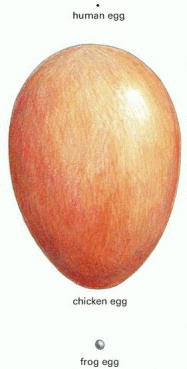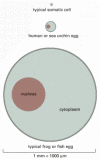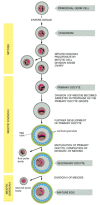By agreement with the publisher, this book is accessible by the search feature, but cannot be browsed.
NCBI Bookshelf. A service of the National Library of Medicine, National Institutes of Health.
Alberts B, Johnson A, Lewis J, et al. Molecular Biology of the Cell. 4th edition. New York: Garland Science; 2002.

Molecular Biology of the Cell. 4th edition.
Show detailsIn one respect at least, eggs are the most remarkable of animal cells: once activated, they can give rise to a complete new individual within a matter of days or weeks. No other cell in a higher animal has this capacity. Activation is usually the consequence of fertilization—fusion of a sperm with the egg. In some organisms, however, the sperm itself is not strictly required, and an egg can be activated artificially by a variety of nonspecific chemical or physical treatments. Indeed, some organisms, including a few vertebrates such as some lizards, normally reproduce from eggs that become activated in the absence of sperm—that is, parthenogenetically.
Although an egg can give rise to every cell type in the adult organism, it is itself a highly specialized cell, uniquely equipped for the single function of generating a new individual. The cytoplasm of an egg can even reprogram a somatic cell nucleus so that the nucleus can direct the development of a new individual. That is how the famous sheep Dolly was produced. The nucleus of an unfertilized sheep egg was destroyed and replaced with the nucleus of an adult somatic cell. An electric shock was used to activate the egg, and the resulting embryo was implanted in the uterus of a surrogate mother. The resulting normal adult sheep had the genome of the donor somatic cell and was therefore a clone of the donor sheep.
In this section, we briefly consider some of the specialized features of an egg before discussing how it develops to the point of being ready for fertilization.
An Egg Is Highly Specialized for Independent Development, with Large Nutrient Reserves and an Elaborate Coat
The eggs of most animals are giant single cells, containing stockpiles of all the materials needed for initial development of the embryo through to the stage at which the new individual can begin feeding. Before the feeding stage, the giant cell cleaves into many smaller cells, but no net growth occurs. The mammalian embryo is an exception. It can start to grow early by taking up nutrients from the mother via the placenta. Thus, a mammalian egg, although still a large cell, does not have to be as large as a frog or bird egg, for example. In general, eggs are typically spherical or ovoid, with a diameter of about 0.1 mm in humans and sea urchins (whose feeding larvae are tiny), 1 mm to 2 mm in frogs and fishes, and many centimeters in birds and reptiles (Figure 20-19). A typical somatic cell, by contrast, has a diameter of only about 10 or 20 μm (Figure 20-20).

Figure 20-19
The actual sizes of three eggs. The human egg is 0.1 mm in diameter.

Figure 20-20
The relative sizes of various eggs. Sizes are compared with that of a typical somatic cell.
The egg cytoplasm contains nutritional reserves in the form of yolk, which is rich in lipids, proteins, and polysaccharides and is usually contained within discrete structures called yolk granules. In some species, each yolk granule is membrane-enclosed, whereas in others it is not. In eggs that develop into large animals outside the mother's body, yolk can account for more than 95% of the volume of the cell. In mammals, whose embryos are largely nourished by their mothers, there is little, if any, yolk.
The egg coat is another peculiarity of eggs. It is a specialized form of extracellular matrix consisting largely of glycoprotein molecules, some secreted by the egg and others deposited on it by surrounding cells. In many species, the major coat is a layer immediately surrounding the egg plasma membrane; in nonmammalian eggs, such as those of sea urchins or chickens, it is called the vitelline layer, whereas in mammalian eggs it is called the zona pellucida (Figure 20-21). This layer protects the egg from mechanical damage, and in many eggs it also acts as a species-specific barrier to sperm, admitting only those of the same or closely related species.

Figure 20-21
The zona pellucida. (A) Scanning electron micrograph of a hamster egg, showing the zona pellucida. (B) A scanning electron micrograph of a similar egg in which the zona (to which many sperm are attached) has been peeled back to reveal the underlying plasma (more...)
Many eggs (including those of mammals) contain specialized secretory vesicles just under the plasma membrane in the outer region, or cortex, of the egg cytoplasm. When the egg is activated by a sperm, these cortical granules release their contents by exocytosis; the contents of the granules act to alter the egg coat so as to prevent more than one sperm from fusing with the egg (discussed below).
Cortical granules are usually distributed evenly throughout the egg cortex, but in some organisms other cytoplasmic components have a strikingly asymmetrical distribution. Some of these localized components later serve to help establish the polarity of the embryo, as discussed in Chapter 21.
Eggs Develop in Stages
A developing egg is called an oocyte. Its differentiation into a mature egg (or ovum) involves a series of changes whose timing is geared to the steps of meiosis in which the germ cells go through their two final, highly specialized divisions. Oocytes have evolved special mechanisms for arresting progress through meiosis: they remain suspended in prophase I for a prolonged period while the oocyte grows in size, and in many cases they later arrest in metaphase II while awaiting fertilization (although they can arrest at various other points, depending on the species).
While the details of oocyte development (oogenesis) vary from species to species, the general stages are similar, as outlined in Figure 20-22. Primordial germ cells migrate to the forming gonad to become oogonia, which proliferate by mitosis for a period before differentiating into primary oocytes. At this stage (usually before birth in mammals), the first meiotic division begins: the DNA replicates so that each chromosome consists of two sister chromatids, the duplicated homologous chromosomes pair along their long axes, and crossing-over occurs between nonsister chromatids of these paired chromosomes. After these events, the cell remains arrested in prophase of division I of meiosis (in a state equivalent, as we previously pointed out, to a G2 phase of a mitotic division cycle) for a period lasting from a few days to many years, depending on the species. During this long period (or, in some cases, at the onset of sexual maturity), the primary oocytes synthesize a coat and cortical granules. In the case of large nonmammalian oocytes, they also accumulate ribosomes, yolk, glycogen, lipid, and the mRNA that will later direct the synthesis of proteins required for early embryonic growth and the unfolding of the developmental program. In many oocytes, the intensive biosynthetic activities are reflected in the structure of the chromosomes, which decondense and form lateral loops, taking on a characteristic “lampbrush” appearance, signifying that they are very busily engaged in RNA synthesis (see Figures 4-36 and 4-37).

Figure 20-22
The stages of oogenesis. Oogonia develop from primordial germ cells that migrate into the developing gonad early in embryogenesis. After a number of mitotic divisions, oogonia begin meiotic division I, after which they are called primary oocytes. In mammals, (more...)
The next phase of oocyte development is called oocyte maturation. It usually does not occur until sexual maturity, when the oocyte is stimulated by hormones. Under these hormonal influences, the cell resumes its progress through division I of meiosis. The chromosomes recondense, the nuclear envelope breaks down (this is generally taken to mark the beginning of maturation), and the replicated homologous chromosomes segregate at anaphase I into two daughter nuclei, each containing half the original number of chromosomes. To end division I, the cytoplasm divides asymmetrically to produce two cells that differ greatly in size: one is a small polar body, and the other is a large secondary oocyte, the precursor of the egg. At this stage, each of the chromosomes is still composed of two sister chromatids. These chromatids do not separate until division II of meiosis, when they are partitioned into separate cells, as previously described. After this final chromosome separation at anaphase II, the cytoplasm of the large secondary oocyte again divides asymmetrically to produce the mature egg (or ovum) and a second small polar body, each with a haploid set of single chromosomes (see Figure 20-22). Because of these two asymmetrical divisions of their cytoplasm, oocytes maintain their large size despite undergoing the two meiotic divisions. Both of the polar bodies are small, and they eventually degenerate.
In most vertebrates, oocyte maturation proceeds to metaphase of meiosis II and then arrests until fertilization. At ovulation, the arrested secondary oocyte is released from the ovary and undergoes a rapid maturation step that transforms it into an egg that is prepared for fertilization. If fertilization occurs, the egg is stimulated to complete meiosis.
Oocytes Use Special Mechanisms to Grow to Their Large Size
A somatic cell with a diameter of 10–20 μm typically takes about 24 hours to double its mass in preparation for cell division. At this rate of biosynthesis, such a cell would take a very long time to reach the thousand-fold greater mass of a mammalian egg with a diameter of 100 μm. It would take even longer to reach the million-fold greater mass of an insect egg with a diameter of 1000 μm. Yet some insects live only a few days and manage to produce eggs with diameters even greater than 1000 μm. It is clear that eggs must have special mechanisms for achieving their large size.
One simple strategy for rapid growth is to have extra gene copies in the cell. Thus, the oocyte delays completion of the first meiotic division so as to grow while it contains the diploid chromosome set in duplicate. In this way, it has twice as much DNA available for RNA synthesis as does an average somatic cell in the G1 phase of the cell cycle. The oocytes of some species go to even greater lengths to accumulate extra DNA: they produce many extra copies of certain genes. We discuss in Chapter 6 how the somatic cells of most organisms require 100 to 500 copies of the ribosomal RNA genes in order to produce enough ribosomes for protein synthesis. Eggs require even greater numbers of ribosomes to support protein synthesis during early embryogenesis, and in the oocytes of many animals the ribosomal RNA genes are specifically amplified; some amphibian eggs, for example, contain 1 or 2 million copies of these genes.
Oocytes may also depend partly on the synthetic activities of other cells for their growth. Yolk, for example, is usually synthesized outside the ovary and imported into the oocyte. In birds, amphibians, and insects, yolk proteins are made by liver cells (or their equivalents), which secrete these proteins into the blood. Within the ovaries, oocytes take up the yolk proteins from the extracellular fluid by receptor-mediated endocytosis (see Figure 13-41). Nutritive help can also come from neighboring accessory cells in the ovary. These can be of two types. In some invertebrates, some of the progeny of the oogonia become nurse cells instead of becoming oocytes. These cells usually are connected to the oocyte by cytoplasmic bridges through which macromolecules can pass directly into the oocyte cytoplasm (Figure 20-23). For the insect oocyte, the nurse cells manufacture many of the products—ribosomes, mRNA, protein, and so on—that vertebrate oocytes have to manufacture for themselves.

Figure 20-23
Nurse cells and follicle cells associated with a Drosophila oocyte. The nurse cells and the oocyte arise from a common oogonium, which gives rise to one oocyte and 15 nurse cells (only 7 of which are seen in this plane of section). These cells remain (more...)
The other accessory cells in the ovary that help to nourish developing oocytes are ordinary somatic cells called follicle cells, which are found in both invertebrates and vertebrates. They are arranged as an epithelial layer around the oocyte (Figure 20-24, and see Figure 20-23), to which they are connected only by gap junctions, which permit the exchange of small molecules but not macromolecules. While these cells are unable to provide the oocyte with preformed macromolecules through these communicating junctions, they may help to supply the smaller precursor molecules from which macromolecules are made. In addition, follicle cells frequently secrete macromolecules that contribute to the egg coat, or are taken up by receptor-mediated endocytosis into the growing oocyte, or act on egg cell-surface receptors to control the spatial patterning and axial asymmetries of the egg (discussed in Chapter 21).

Figure 20-24
Electron micrographs of developing primary oocytes in the rabbit ovary. (A) An early stage of primary oocyte development. Neither a zona pellucida nor cortical granules have developed, and the oocyte is surrounded by a single layer of flattened follicle (more...)
Summary
Eggs develop in stages from primordial germ cells that migrate into the developing gonad early in development to become oogonia. After mitotic proliferation, oogonia become primary oocytes, which begin meiotic division I and then arrest at prophase I for days to years, depending on the species. During this prophase-I arrest period, primary oocytes grow, synthesize a coat, and accumulate ribosomes, mRNAs, and proteins, often enlisting the help of other cells, including surrounding accessory cells. In the process of maturation, primary oocytes complete meiotic division I to form a small polar body and a large secondary oocyte, which proceeds into metaphase of meiotic division II. There, in many species, the oocyte is arrested until stimulated by fertilization to complete meiosis and begin embryonic development.
- Eggs - Molecular Biology of the CellEggs - Molecular Biology of the Cell
- ACO2 [Capra hircus]ACO2 [Capra hircus]Gene ID:102190495Gene
- LOC122781015 [Solea senegalensis]LOC122781015 [Solea senegalensis]Gene ID:122781015Gene
- LOC122760665 [Solea senegalensis]LOC122760665 [Solea senegalensis]Gene ID:122760665Gene
Your browsing activity is empty.
Activity recording is turned off.
See more...